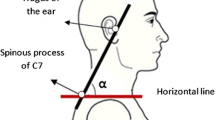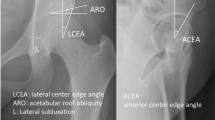Summary
Numerous studies of the bicondylar angle of the adult femur have been carried out in human anatomy, paleoanthropology and primatology. The aim of this paper is to study the evolution of this angle in relation to age and acquisition of walking in young children. Seventy-seven radiographs of children, ranging from 5 months to 17 years postnatally, and of four dead newborn were analysed. The measurements concern the bicondylar angle (A.O.F.), the collo-diaphyseal angle (A.C.D.), the length of the femoral neck (L.N.) and of the femur (L.F.) and the interacetabular distance (D.I.A.). Some children were x-rayed at different ages, which permits a longitudinal as well cross-sectional study. The results show that there is no sexual dimorphism and that the increase in the angle is closely related to the age of the child. The bicondylar angle starts at 0° at birth and then increases progressively with growth to reach adult values of at least 6°–8° between 4 and 8 years postnatally. In adults, the mean values are between 8° and 11° and the maximum range is between 6° and 14°. The obliquity angle corresponds to an angular remodeling of the femoral diaphysis, which is independant of the growth and shape of the distal femoral epiphysis. The tibiofemoral angle measures the evolution of a physiologic phenomenon, from the load “in varus” to the load “in valgus” of the lower limb. It is linked with the bicondylar angle but is different from it.
Résumé
L'étude de l'angle bicondylaire du fémur a fait l'objet de nombreux travaux en anatomie humaine, en paléoanthropologie et en primatologie. Le but de cet article est d'en étudier l'évolution en fonction de l'âge et de l'acquisition de la marche. Soixante-dixsept radiographies d'enfants âgés de 5 mois à 17 ans et de 4 nouveau-nés décédés ont été analysées. Les mesures ont porté sur l'angle bicondylaire (A.O.F.), l'angle cervico-diaphysaire (A.C.D.), la longueur du col (L.C.), du fémur (L.F.) et la distance interacétabulaire (D.I.A.). Certains enfants ont été radiographiés à différents âges, permettant une analyse longitudinale et transversale. Les résultats montrent qu'il n'y a aucun dimorphisme sexuel et que l'évolution de l'angle est étroitement corrélée avec l'âge de l'enfant. L'angle bicondylaire est nul à la naissance, augmente progressivement avec la croissance et atteint une valeur proche de la valeur adulte entre 4 et 8 ans. La valeur moyenne varie entre 8° et 11° et les valeurs extrêmes entre 6° et 14° dans les études faites chez les adultes. Cet angle d'obliquité correspond à un remodelage angulaire de la diaphyse distale, indépendant de la croissance et de la forme de l'épiphyse fémorale inférieure. Il est différent de l'angle tibiofémoral dont l'évolution est un phénomène physiologique.
Similar content being viewed by others
References
Bedouelle J (1982) Antétorsion des cols fémoraux. Rev Chir Orthop 68: 5–13
Cahuzac JP (1989) Vices de torsion des membres inférieurs. Cahiers d'Enseignement de la SOFCOT. Expansion scientifique, Paris. Conférences d'enseignement, pp 35–45
Fabry G, McEven GD, Shands AR (1973) Torsion of the femur. A follow-up study in normal and abnormal conditions. J Bone Joint Surg 55: 1726
Halaczek B (1972) Die Langknochen der Hinterextremität bei Simischen Primaten. Juris Druck und Verlag, Zürich
Harris NH (1976) Acetabular growth potential in congenital dislocation of the hip and some factors upon which it may depend. Clin Orthop 119: 99–106
Heiple KG, Lovejoy CO (1971) The distal femoral anatomy of Australopithecus. Am J Phys Anthrop 35: 75–84
Johanson D and Coppens Y (1976) A preliminary anatomical diagnosis of the first Plio/Pleistocene hominid discoveries in the Central Afar, Ethiopia. Am J Phys Anthrop 45: 217–222
LeGros Clark WE (1947) The importance of the fossil Australopithecinae in the study of human evolution. Sci Prog 35: 377–395
Lerat J L et Taussig G (1982) Les anomalies de rotation des membres inférieurs. Rev Chir Orthop 68: 1–74
Lovejoy CO, Heiple KJ, Burstein AH (1973) The gait of Australopithecus. Am J Phys Anthrop 38: 757–780
Lude L, Taillard W (1964) Le développement de la congruence articulaire de la hanche chez l'enfant. Rev Chir Orthop 50: 758–777
Mac Mahon EB, Carmines DV, Irani RN (1995) Physiologic bowing in children: an analysis of the Pendulum Mechanism. J Pediatr Orthop, Part B, 4: 100–105
Parsons FG (1914) The characters of the English thigh bone. J Anat Physiol 48: 238–267
Pauwels F (1979) Biomécanique de l'appareil locomoteur. Springer-Verlag, Berlin Heidelberg New York
Pous JG, Dimeglio A, Baldet P, Bonnel F (1980) Cartilage de conjugaison et croissance. Notions fondamentales en orthopédie. Doin, Paris
Robinson JT (1972) Early hominid posture and locomotion. University of Chicago Press, Chicago
Salenius P, Vankka E (1975) The development of the tibiofemoral angle in children. J Bone Joint Surg [Am] 57-A: 259–261
Shands AR, Steele MK (1958) Torsion of the femur. J Bone Joint Surg 40: 803
Taussig G, Delor M H, Masse P (1976) Les altérations de croissance de l'extrémité supérieure du fémur. Rev Chirg Orthop 62: 191–210
Tardieu Ch (1983) L'articulation du genou chez les Primates. Presses du C.N.R.S., Paris
Tardieu Ch (1993) L'angle bicondylaire du fémur est-il homologue chez l'homme et les primates non humains ? Réponse ontogénétique. Bull Mem Soc Anthrop Paris 5: 159–168
Tardieu Ch (1994) Morphogenèse de la diaphyse fémorale chez l'homme. Signification fonctionnelle et évolutive. Folia Primatol 63: 53–58
Tardieu Ch, Trinkaus E (1994) The early ontogeny of the human femoral bicondylar angle. Am J Phys Anthrop 95: 183–195
Vallois H (1920) L'épiphyse inférieure du fémur chez les Primates. Bull Mém Soc Anthrop Paris 10: 27–54
Von Lanz T, Mayet A (1953) Die Gelenkörper des menschlichen Hufgelenkes in der progredienten Phase ihrer umwegigen Ausformung. Z Anat 117: 317–345
Walmsley T (1933) The vertical axes of the femur. J Anat 67: 284–300
Watanabe RS (1974) Embryology of the human hip. Clin Orthop 98: 8–26
Author information
Authors and Affiliations
Rights and permissions
About this article
Cite this article
Tardieu, C., Damsin, J.P. Evolution of the angle of obliquity of the femoral diaphysis during growth — correlations. Surg Radiol Anat 19, 91–97 (1997). https://doi.org/10.1007/BF01628132
Received:
Accepted:
Issue Date:
DOI: https://doi.org/10.1007/BF01628132




